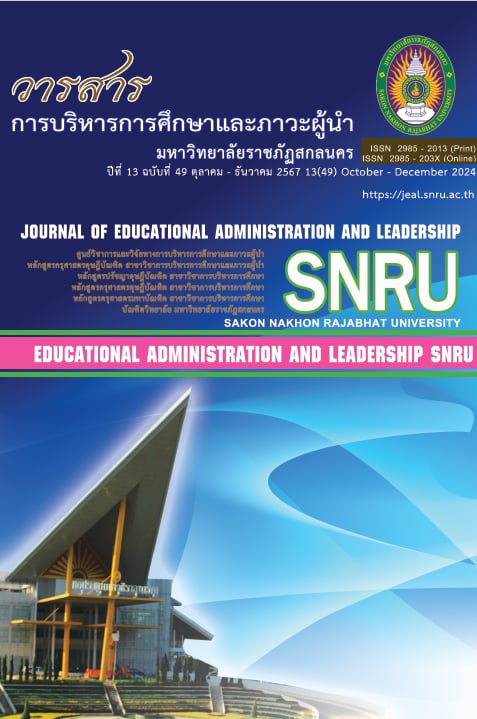

ภาวะผู้นำเชิงวิสัยทัศน์ของผู้บริหารที่ส่งผลต่อแรงจูงใจในการปฏิบัติงานของครูในโรงเรียน สังกัดสำนักงานเขตพื้นที่การศึกษาประถมศึกษาสกลนคร เขต 2
Visionary Leadership of Administrators Affecting Performance Motivation of Teachers in Schools under Sakon Nakhon Primary Educational Service Area Office 2
ผู้แต่ง
วิลาสินี ศรีประทุมวงศ์, เพ็ญผกา ปัญจนะ, รัชฎาพร งอยภูธร
Author
Vilasinee Sriprathumwong, Penphaka Panjana, Rutchadapohn Ngoiphuthorn
บทคัดย่อ
การวิจัยครั้งนี้มีวัตถุประสงค์เพื่อศึกษา เปรียบเทียบ หาความสัมพันธ์ หาอำนาจพยากรณ์ และการหาแนวทางพัฒนาภาวะผู้นำเชิงวิสัยทัศน์ของผู้บริหารที่ส่งผลต่อแรงจูงใจในการปฏิบัติงานของครูในโรงเรียน สังกัดสำนักงานเขตพื้นที่การศึกษาประถมศึกษาสกลนคร เขต 2 กลุ่มตัวอย่างที่ใช้ในการวิจัยมีจำนวน 339 คน ประกอบด้วยผู้บริหารสถานศึกษา จำนวน 79 คน ครูผู้สอน 260 คน สังกัดสำนักงานเขตพื้นที่การศึกษาประถมศึกษาสกลนคร เขต 2 กำหนดขนาดกลุ่มตัวอย่างโดยใช้ตารางสำเร็จรูป Krejci & Morgan โดยใช้วิธีสุ่มแบบหลายขั้นตอน (Multi - Stage Random Sampling) การเก็บรวบรวมข้อมูลใช้แบบสอบถามชนิดมาตราส่วนประมาณ 5 ระดับ ประกอบด้วย แบบสอบถามเกี่ยวกับภาวะผู้นำเชิงวิสัยทัศน์ของผู้บริหาร มีค่าอำนาจจำแนกอยู่ระหว่าง 0.611 - 0.942 และค่าความเชื่อมั่นเท่ากับ 0.971 และแบบสอบถามเกี่ยวกับแรงจูงใจในการปฏิบัติงานของครูในโรงเรียนมีค่าอำนาจจำแนกอยู่ระหว่าง 0.365 - 0.876 และค่าความเชื่อมั่น เท่ากับ 0.934 สถิติที่ใช้ในการวิเคราะห์ข้อมูล ได้แก่ ความถี่ ร้อยละ ค่าเฉลี่ย และส่วนเบี่ยงเบนมาตรฐาน การทดสอบค่าที (t - test ชนิด Independent Samples) การวิเคราะห์ความแปรปรวนทางเดียว (One - Way ANOVA) การวิเคราะห์ค่าสัมประสิทธิ์สหสัมพันธ์อย่างง่ายของเพียร์สัน (Pearson Product – Moment Correlation Coefficient) และการวิเคราะห์การถดถอยพหุคุณแต่ละขั้นตอน (Stepwise Multiple Regression analysis) และแบบสัมภาษณ์แนวทางพัฒนาภาวะผู้นำเชิงวิสัยทัศน์ของผู้บริหารที่ส่งผลต่อแรงจูงใจในการปฏิบัติงานของครูในโรงเรียน ผลการวิจัยพบว่า 1. ภาวะผู้นำเชิงวิสัยทัศน์ของผู้บริหารโดยรวม อยู่ในระดับมาก 2. แรงจูงใจในการปฏิบัติงานของครูในโรงเรียนโดยรวม อยู่ในระดับมาก 3. ภาวะผู้นำเชิงวิสัยทัศน์ของผู้บริหาร จําแนกตามสถานภาพการดำรงตำแหน่ง พบว่า โดยรวมแตกต่างกันอย่างมีนัยสำคัญทางสถิติที่ระดับ .01 แต่จำแนกตามขนาดของโรงเรียนและตามประสบการณ์ในการทำงาน พบว่า โดยรวมไม่แตกต่างกัน 4. แรงจูงใจในการปฏิบัติงานของครูในโรงเรียน จําแนกตามสถานภาพการดำรงตำแหน่ง และจำแนกตามขนาดของโรงเรียน พบว่า โดยรวมแตกต่างกันอย่างมีนัยสำคัญทางสถิติที่ระดับ .05 และ .01 แต่จำแนกตามประสบการณ์ในการทำงาน พบว่า โดยรวมไม่แตกต่างกัน 5. ความสัมพันธ์ระหว่างภาวะผู้นำเชิงวิสัยทัศน์ของผู้บริหารและแรงจูงใจในการปฏิบัติงานของครูในโรงเรียน พบว่า มีความสัมพันธ์ทางบวก อยู่ในระดับสูง อย่างมีนัยสำคัญทางสถิติที่ระดับ .01 โดยมีค่าสัมประสิทธิ์สหสัมพันธ์เท่ากับ .756 6. ภาวะผู้นำเชิงวิสัยทัศน์ที่สามารถพยากรณ์แรงจูงใจในการปฏิบัติงานของครูในโรงเรียน โดยรวมได้อย่างมีนัยสำคัญทางสถิติที่ระดับ .01 จำนวน 4 ด้าน ได้แก่ ด้านการเป็นแบบอย่างที่ดีเชิงวิสัยทัศน์ ด้านการสร้างนวัตกรรมสู่วิสัยทัศน์ ด้านการนำวิสัยทัศน์สู่การปฏิบัติ และด้านการมองภาพอนาคตเชิงวิสัยทัศน์ ได้ร้อยละ 56.80 และมีความคลาดเคลื่อนมาตรฐานของการพยากรณ์ เท่ากับ ±0.25658 7. แนวทางในการพัฒนาภาวะผู้นำเชิงวิสัยทัศน์ของผู้บริหารที่ส่งผลต่อแรงจูงใจในการปฏิบัติงานของครูในโรงเรียน จำนวน 4 ด้าน ได้แก่ ด้านการเป็นแบบอย่างที่ดีเชิงวิสัยทัศน์ ด้านการสร้างนวัตกรรมสู่วิสัยทัศน์ ด้านการนำวิสัยทัศน์สู่การปฏิบัติ และด้านการมองภาพอนาคตเชิงวิสัยทัศน์
Abstract
The purposes of this research were to examine, compare, and identify the relationship, determine the predictive power, and establish guidelines for developing visionary leadership of administrators affecting the performance motivation of teachers in schools under Sakon Nakhon Primary Educational Service Area Office 2. The sample consisted of 339 participants, including 79 school administrators, and 260 teachers in the 2023 academic year. The sample size was determined through the Krejcie and Morgan table and multi-stage random sampling. The instrument for data collection included sets of 5 - level rating scale questionnaires: visionary leadership of administrators with the discriminative power ranging from 0.611 to 0.942 and the reliability of 0.971, and the performance motivation teachers with the discriminative power ranging from 0.365 to 0.876 and the reliability of 0.934. Statistics for data analysis were frequency, percentage, mean, standard deviation, Independent Samples t-test, One-Way ANOVA, Pearson's product-moment correlation coefficient, and Stepwise multiple regression analysis. The interviews were also conducted to establish guidelines for improving administrators’ visionary leadership affecting teachers’ performance motivation within schools. The results were as follows: 1. The administrators’ visionary leadership was overall at a high level. 2. The teachers’ performance motivation within schools was overall at a high level. 3. The administrators’ visionary leadership, classified by positions, was overall at the .01 level of significance, whereas there was no difference overall in terms of school sizes, and work experience. 4. The overall teachers’ performance motivation in schools, classified by positions and school sizes, showed differences at the .05 level of significance and the .01 level of significance, respectively. In terms of school sizes, a significant difference was observed overall at the .01 level of significance, whereas no significant difference was found overall in work experience. 5. The relationship between administrators’ visionary leadership and teachers’ performance motivation in schools was positive overall at a high level with the .01 level of significance and a correlation coefficient of rxy = .756. 6. The administrators’ visionary leadership, consisting of four aspects: Visionary Role Model, Creating Innovation toward Vision, Vision Implementation, and Futuristic Visioning Perspective, could predict teachers’ performance motivation within schools at the .01 level of significance with 56.80 percent and a standard error of estimate of ±0.25658. 7. The guidelines for developing visionary leadership of administrators affecting teachers’ performance motivation in schools, consisted of four aspects: Visionary Role Model: Administrators must be visionary role models to encourage personnel to perform their tasks with the schools’ vision; Creating Innovation toward Vision: Administrators should possess visions, and implement technology innovations regularly; Vision Implementation: Administrators are advised to promote and support personnel in employing strategies for achieving success; and Futuristic Visioning Perspective: Administrators and personnel are advised to analyze both internal and external circumstances within the organization.
คำสำคัญ
ภาวะผู้นำเชิงวิสัยทัศน์ของผู้บริหาร, แรงจูงใจในการปฏิบัติงานของครูในโรงเรียนKeyword
Visionary Leadership of Administrators, Teachers’ Performance MotivationNotice: Undefined variable: dataSet in /var/www/html/ArticleView.php on line 116
Notice: Trying to access array offset on value of type null in /var/www/html/ArticleView.php on line 116
บทความทุกบทความเป็นลิขสิทธิ์ของ
Notice: Undefined variable: dataSet in /var/www/html/ArticleView.php on line 116
Notice: Trying to access array offset on value of type null in /var/www/html/ArticleView.php on line 116
เท่านั้น
กำลังออนไลน์: 20
วันนี้: 11,639
เมื่อวานนี้: 24,433
จำนวนครั้งการเข้าชม: 998,036
อาคารบัณฑิตวิทยาลัย ชั้น 2 ตำบลธาตุเชิงชุม อำเภอเมือง จังหวัดสกลนคร 47000
โทร/
แฟกซ์ 0-4297-0093
บรรณาธิการ: รองศาสตราจารย์ ดร.ไชยา ภาวะบุตร
ติดต่อ/สอบถาม: นายธีรเวทย์ เพียรธัญญกรณ์
โทร: 0-4297-0093